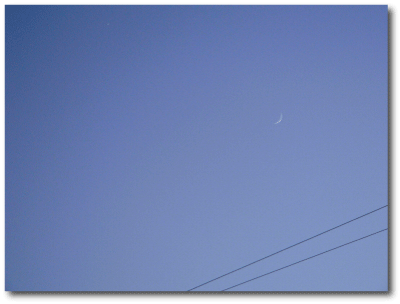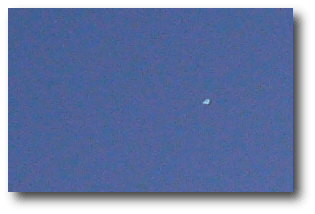
Image Source.
Two evenings ago, Venus and the Moon hung close together in the deep blue twilight. Their alignment, along with the location of the fading sunset glow, gave a suggestion of the sweep of the ecliptic plane.

Zooming in on the pixels of the above photograph, it’s just possible to see that Venus is not a point source. The hint of a half-illuminated world indicates that the planet is now fairly near maximum elongation. In our lifetimes, I think we’ll likely see images of habitable extrasolar terrestrial planets that harbor something like this level of detail.
Venus gets a bad rap because the surface is so unpleasant. The Venera landers were built like submarines, and yet they still managed only an hour or two on the ground before expiring. The coke-bottle lens panoramas of basaltic slabs that they radioed back do little to fire the imagination.
My attitude toward Venus was transformed by David Grinspoon’s Venus Revealed, which I think is probably the best trade book ever written on planetary science. The text is filled with gems of insight. One passage that sticks is:
There is a level in the clouds (about 33 miles up), where the atmospheric pressure is about 70% of the pressure at sea level on Earth, and the temperature is a balmy 107 degrees Fahrenheit. For ballooning at this altitude on Venus, you would need only a thin, acid resistant suit, and oxygen tank and a large supply of cold lemonade. It’s cool enough for liquid water, and small amounts of it exist there (in a strong sulfuric acid solution).
By contrast there’s no place on Mars that could be explored using gear from an Army Surplus store.
Are there other similarly “visitable” environments in the Solar System? Surprisingly, the answer is yes. On Jupiter, at a level where the atmospheric pressure is ~6 times that at sea level, the temperature is chilly, and yet still comfortably above freezing. This level (at which hot tea might be preferable to lemonade) lies in the midst of the Jovian water cloud deck, and is subject to torrential downpours accompanied by lightning and thunder. If one were ballooning at this level, you would see an misty gray expanse, stabbed by lightning discharges, with the rotten-egg smell of hydrogen sulfide seeping in through your uncomfortably heavy scuba-store face mask.

Hi Greg,
It’s funny that you should mention ballooning on Jupiter. Last night I was listening Andy Ingersoll of Caltech talking about that very same thing on the TV program “The Universe” which is aired on the History Channel every Tuesday night where I live. He said it’s doable. All you would need is a high-altitude balloon filled with “hot” hydrogen. Of course, I think we all know the dangers that are involved with heated hydrogen. But what the heck…it would be one heck of a view while it lasted, and there are worse ways to go, I guess. :-)
best,
Eric
I almost forgot about the ice-fishing, Greg. Think about it… ballooning with Andy Ingersoll on Jupiter and then later, ice-fishing with Neil deGrasse Tyson on Europa with a few beers? Sounds like a fun weekend to me. I just don’t think that people realize the recreational opportunities that await them in our solar system. ;-)
best,
Eric
Personally, I’d take the Venus visit over the Jupiter one: the gravity isn’t cripplingly high, and there aren’t nasty radiation belts all over the place!
What kind of altitude (on Earth) does 70% of the sea-level pressure correspond to?
Hi Andy,
You know when you think about it, it’s amazing that the spacecraft that we’ve sent to Jupiter–Voyager, Galileo and even the Cassini-Huygens flyby–were able to survive Jupiter’s formidable magnetosphere. I guess those guys and gals at JPL really do know what they’re doing. I heard Andy Ingersoll of Caltech say that Jupiter’s magnetosphere is a lot larger than the sun itself, and that the radiation produced by the constant bombardment of Jupiter’s magnetosphere by the protons and electrons of the solar wind is unimaginable. It is truly an awe-inspiring phenomenon.
Now that you mention it, I too am curious to know at what altitude the atmospheric pressure of Earth is 70% of that at sea-level.
best,
Eric
A 70% atmospheric pressure is at roughly 13000 feet altitude, much more manageable than the sulfuric acid rain.
Hi Darin,
So basically, it wouldn’t be much worse than a visit to the summit of Mauna Kea, if you didn’t have the sulfuric acid clouds. Upon rereading Greg’s original blog, I see that he quotes David Grinspoon’s Venus Revealed in which he refers to an altitude of about 33 miles up. I must have missed that the first time. I could handle that. Thanks for the info.
best,
Eric
Hi All,
I realized after I uploaded my last reply that the sloppy way in which I wrote it left room for confusion and misunderstanding. So, being the perfectionist and compulsive nut that I am I feel compelled to clarify what I was trying to say.
On Earth where the atmospheric density is much less than what it is on Venus, you would have 70% of the atmospheric pressure that you would have at sea-level at an altitude of roughly 13,000 feet.
On the other hand, according to the quote from David Grinspoon’s Venus Revealed, on Venus, because it has a much denser atmosphere than Earth’s, you would have 70% of Earth’s atmospheric pressure of that at sea-level at an altitude of 33 miles.
I hope that clarifies what I meant. I apologize if I caused any confusion. I need to learn to think about what I’m writing before actually submitting it.
Again, thanks for the info, Darin.
best,
Eric